
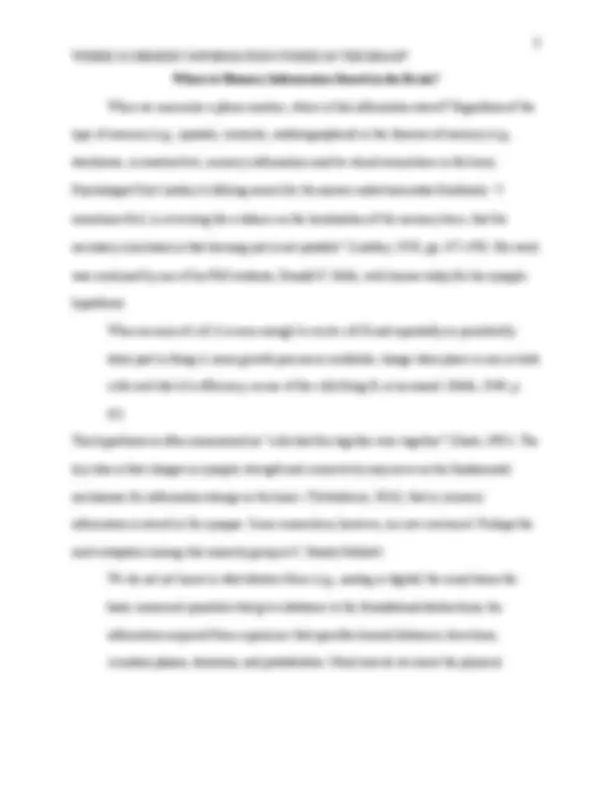
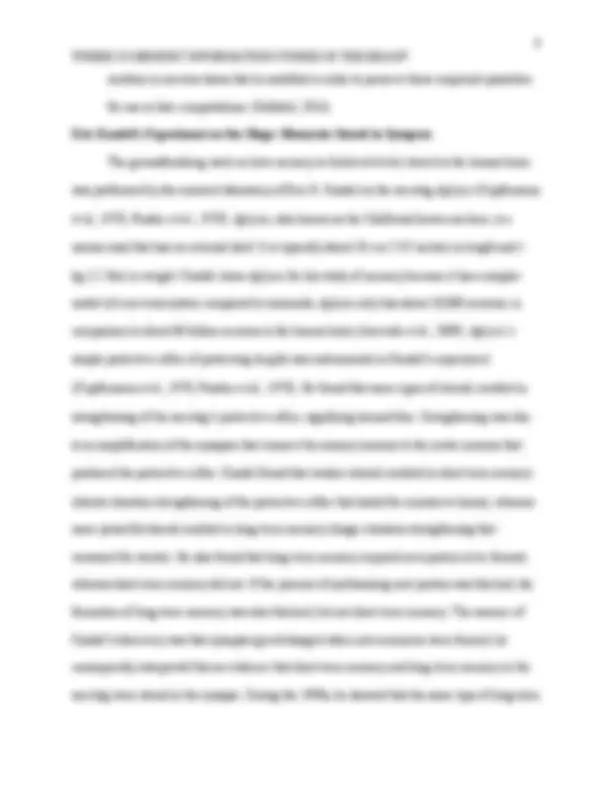
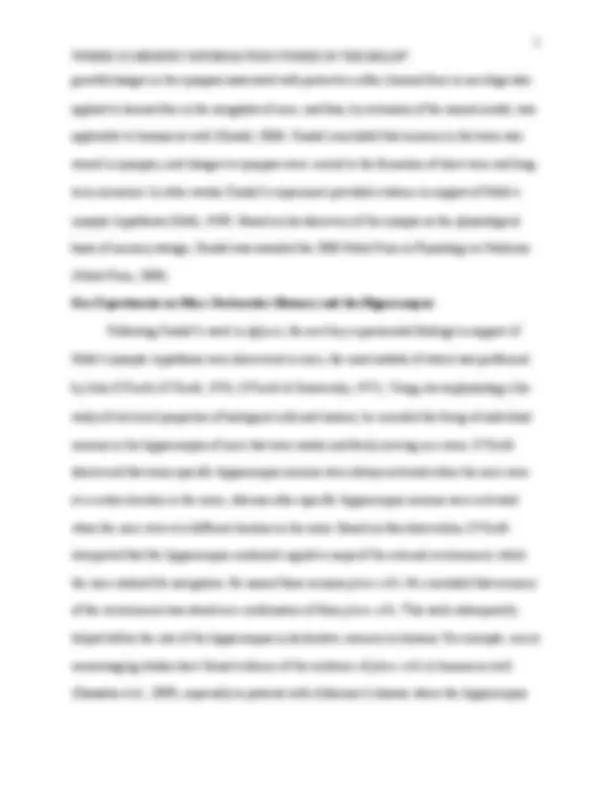
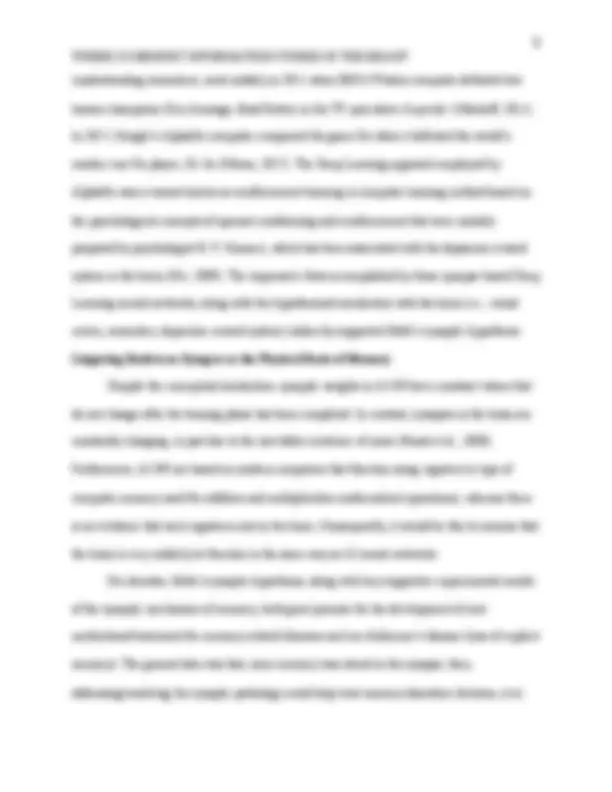
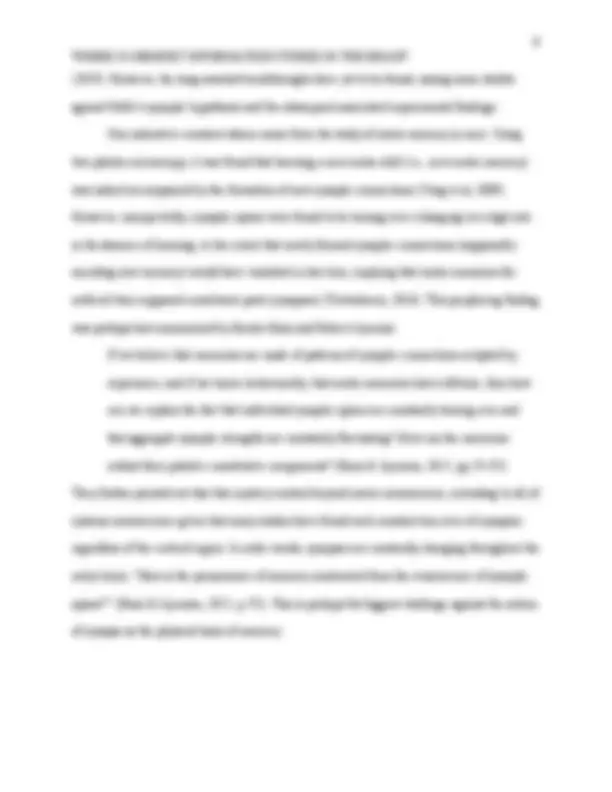
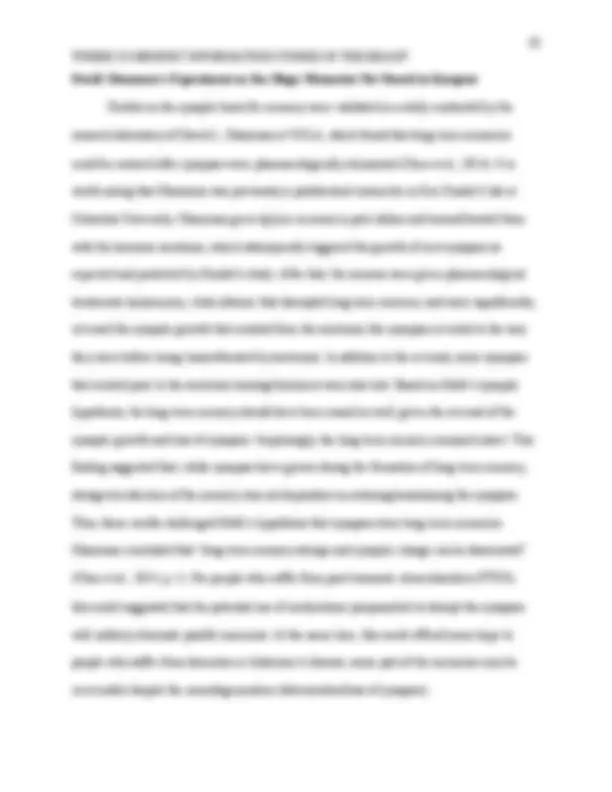
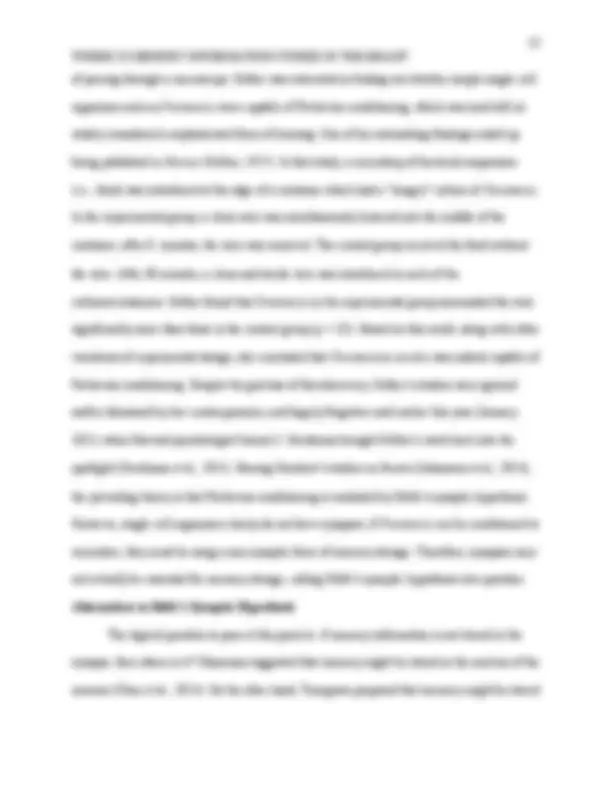
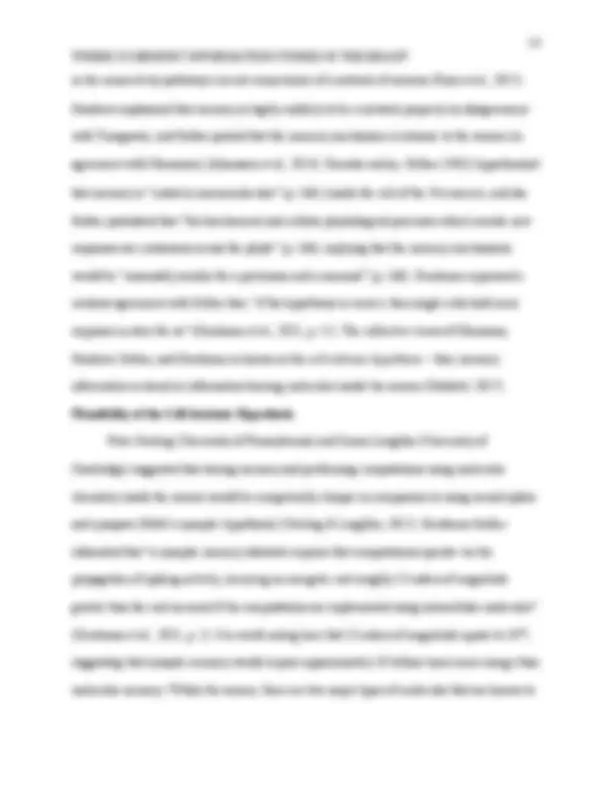
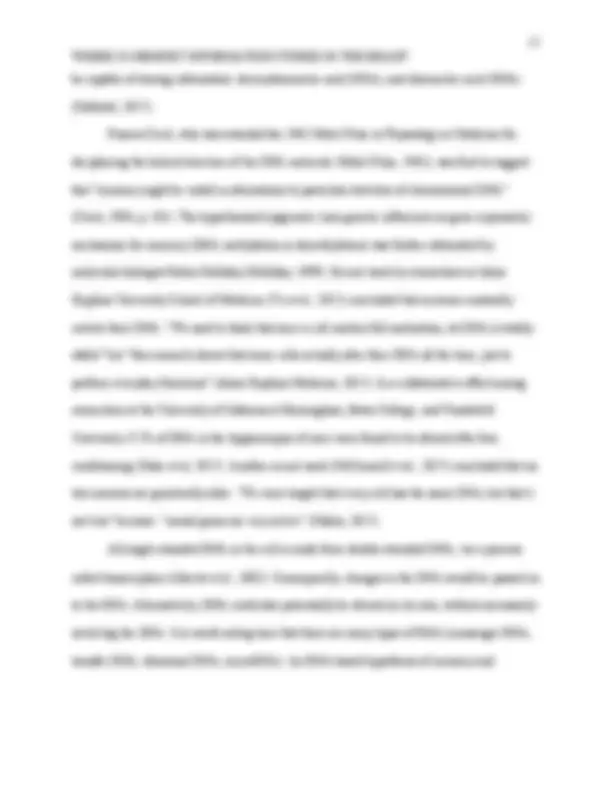
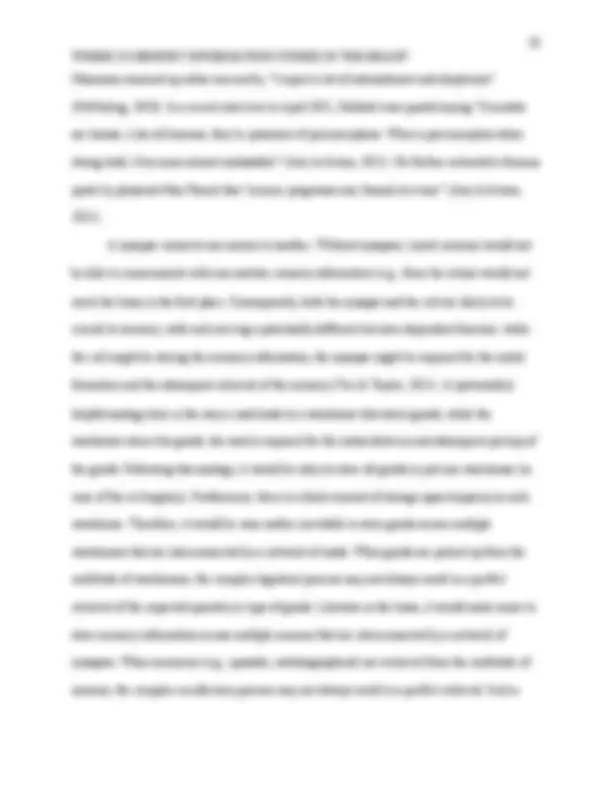
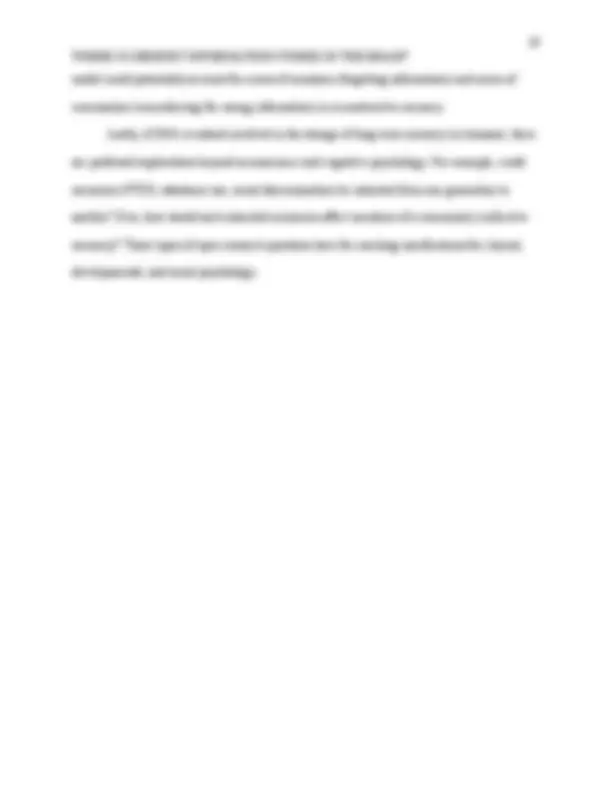
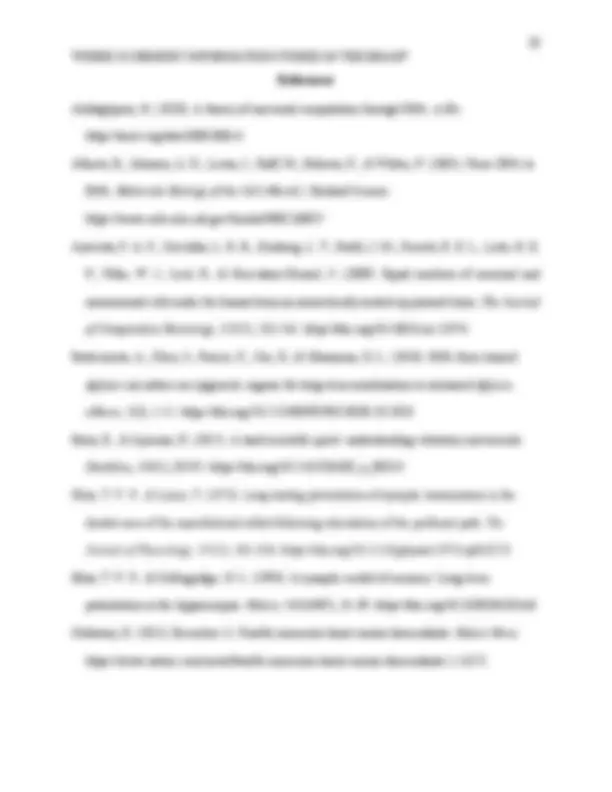
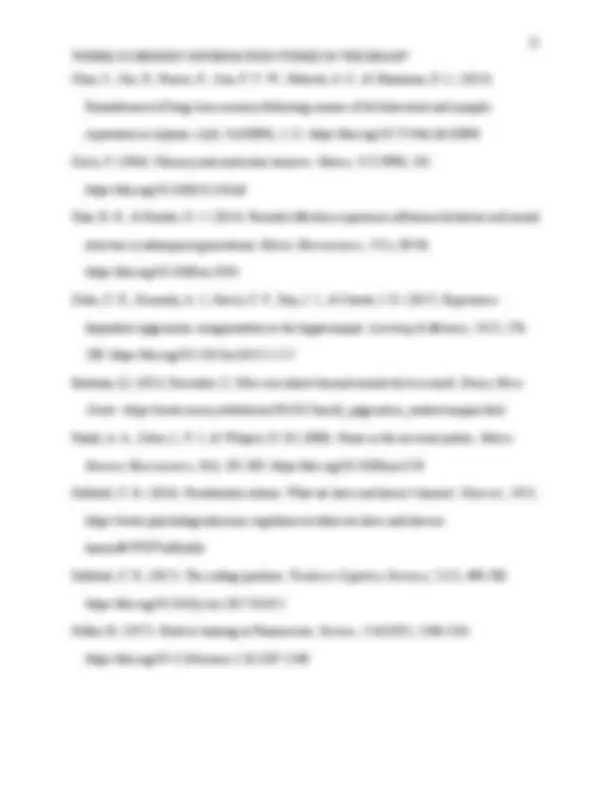
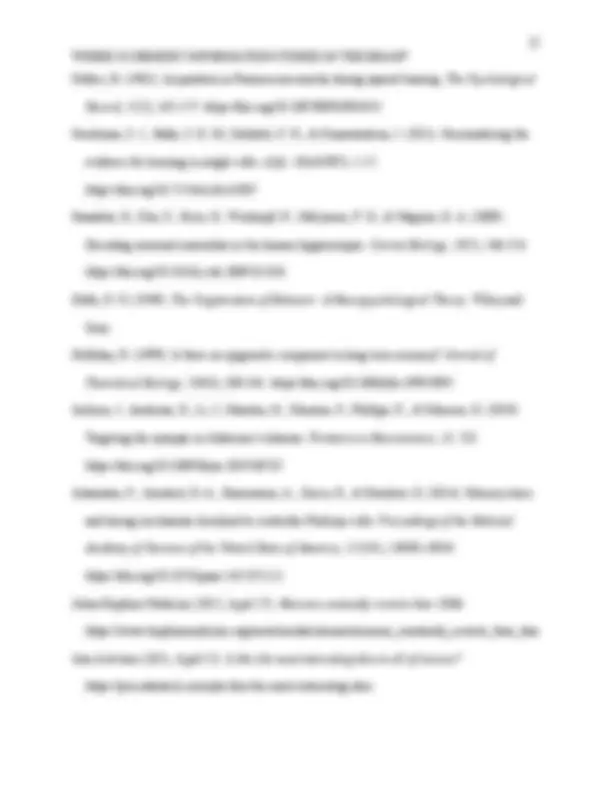
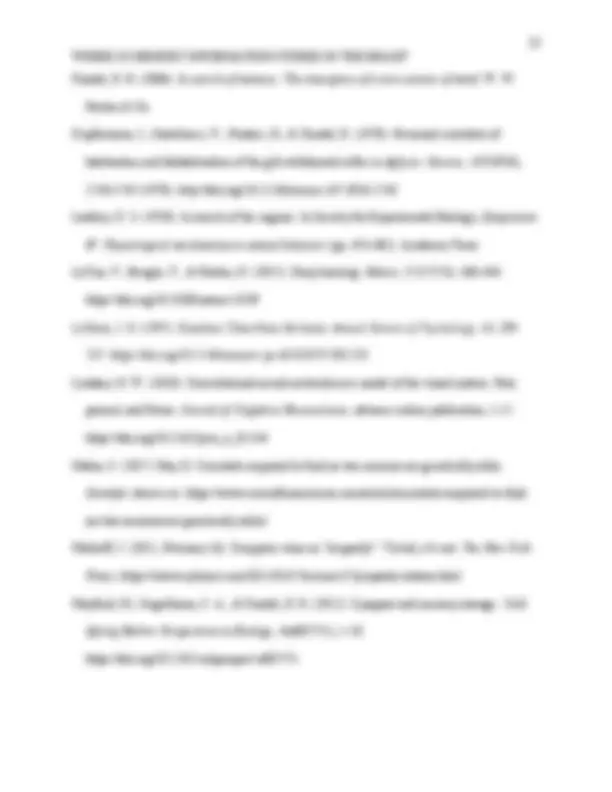


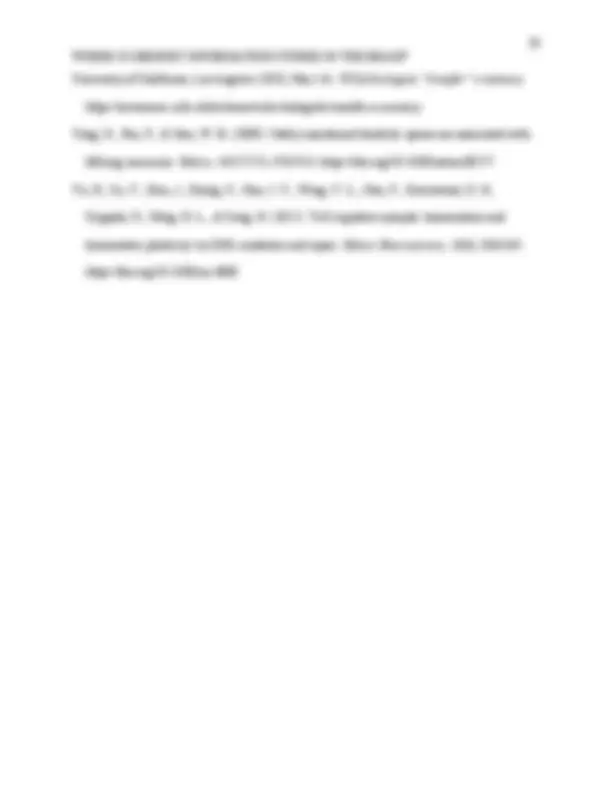


Study with the several resources on Docsity

Earn points by helping other students or get them with a premium plan


Prepare for your exams
Study with the several resources on Docsity

Earn points to download
Earn points by helping other students or get them with a premium plan
Community
Ask the community for help and clear up your study doubts
Discover the best universities in your country according to Docsity users
Free resources
Download our free guides on studying techniques, anxiety management strategies, and thesis advice from Docsity tutors
The groundbreaking research on memory storage in the brain by Eric Kandel, Joseph LeDoux, David Glanzman, and Susumu Tonegawa. Kandel's discovery that synapses change when new memories are formed led to the synaptic hypothesis, while LeDoux's experiments on conditioned fear responses in mice challenged this hypothesis. Glanzman's study on sea slugs showed that long-term memories could be stored without synaptic changes, and Tonegawa's replication of Glanzman's experiment further supported this finding. The document also discusses the implications of these findings for the understanding of memory storage and the challenges to Hebb's synaptic hypothesis.
Typology: Study notes
1 / 26

This page cannot be seen from the preview
Don't miss anything!



















Where is Memory Information Stored in the Brain? James Tee,1,2^ and Desmond P. Taylor^2 (^1) Department of Psychology, The New School for Social Research, USA. (^2) Department of Electrical and Computer Engineering, University of Canterbury, New Zealand. james.tee@newschool.edu Accepted for publication (Dec 8, 2021) in The New School Psychology Bulletin.
Abstract Within the scientific research community, memory information in the brain is commonly believed to be stored in the synapse – a hypothesis famously attributed to psychologist Donald Hebb. However, there is a growing minority who postulate that memory is stored inside the neuron at the molecular (RNA or DNA) level – an alternative postulation known as the cell- intrinsic hypothesis, coined by psychologist Randy Gallistel. In this paper, we review a selection of key experimental evidence from both sides of the argument. We begin with Eric Kandel’s studies on sea slugs, which provided the first evidence in support of the synaptic hypothesis. Next, we touch on experiments in mice by John O’Keefe (declarative memory and the hippocampus) and Joseph LeDoux (procedural fear memory and the amygdala). Then, we introduce the synapse as the basic building block of today’s artificial intelligence neural networks. After that, we describe David Glanzman’s study on dissociating memory storage and synaptic change in sea slugs, and Susumu Tonegawa’s experiment on reactivating retrograde amnesia in mice using laser. From there, we highlight Germund Hesslow’s experiment on conditioned pauses in ferrets, and Beatrice Gelber’s experiment on conditioning in single-celled organisms without synapses ( Paramecium aurelia ). This is followed by a description of David Glanzman’s experiment on transplanting memory between sea slugs using RNA. Finally, we provide an overview of Brian Dias and Kerry Ressler’s experiment on DNA transfer of fear in mice from parents to offspring. We conclude with some potential implications for the wider field of psychology. Keywords: memory, information, brain, neuron, synaptic hypothesis, cell-intrinsic hypothesis
medium in nervous tissue that is modified in order to preserve these empirical quantities for use in later computations. (Gallistel, 2016) Eric Kandel’s Experiment on Sea Slugs: Memories Stored in Synapses The groundbreaking work on how memory is (believed to be) stored in the human brain was performed by the research laboratory of Eric R. Kandel on the sea slug Aplysia (Kupfermann et al., 1970; Pinsker et al., 1970). Aplysia , also known as the California brown sea hare, is a marine snail that has no external shell. It is typically about 20 cm (7.87 inches) in length and 1 kg (2.2 lbs) in weight. Kandel chose Aplysia for his study of memory because it has a simpler model of a nervous system compared to mammals; Aplysia only has about 20,000 neurons, in comparison to about 86 billion neurons in the human brain (Azevedo et al., 2009). Aplysia’s simple protective reflex of protecting its gills was instrumental in Kandel’s experiment (Kupfermann et al., 1970; Pinsker et al., 1970). He found that some types of stimuli resulted in strengthening of the sea slug’s protective reflex, signifying learned fear. Strengthening was due to an amplification of the synapses that connect the sensory neurons to the motor neurons that produced the protective reflex. Kandel found that weaker stimuli resulted in short-term memory (shorter duration strengthening of the protective reflex that lasted for minutes to hours), whereas more powerful stimuli resulted in long-term memory (longer duration strengthening that remained for weeks). He also found that long-term memory required new protein to be formed, whereas short-term memory did not. If the process of synthesizing new protein was blocked, the formation of long-term memory was also blocked, but not short-term memory. The essence of Kandel’s discovery was that synapses grew/changed when new memories were formed; he consequently interpreted this as evidence that short-term memory and long-term memory in the sea slug were stored in the synapse. During the 1990s, he showed that the same type of long-term
growth/changes in the synapses associated with protective reflex (learned fear) in sea slugs also applied to learned fear in the amygdala of mice, and thus, by extension of the animal model, was applicable to humans as well (Kandel, 2006). Kandel concluded that memory in the brain was stored in synapses, and changes to synapses were central to the formation of short-term and long- term memories. In other words, Kandel’s experiment provided evidence in support of Hebb’s synaptic hypothesis (Hebb, 1949). Based on his discovery of the synapse as the physiological basis of memory storage, Kandel was awarded the 2000 Nobel Prize in Physiology or Medicine (Nobel Prize, 2000). Key Experiments on Mice: Declarative Memory and the Hippocampus Following Kandel’s work in Aplysia , the next key experimental findings in support of Hebb’s synaptic hypothesis were discovered in mice, the most notable of which was performed by John O’Keefe (O’Keefe, 1976; O’Keefe & Dostrovsky, 1971). Using electrophysiology (the study of electrical properties of biological cells and tissues), he recorded the firing of individual neurons in the hippocampus of mice that were awake and freely moving in a room. O’Keefe discovered that some specific hippocampus neurons were always activated when the mice were at a certain location in the room, whereas other specific hippocampus neurons were activated when the mice were at a different location in the room. Based on this observation, O’Keefe interpreted that the hippocampus contained cognitive maps of the external environment, which the mice utilized for navigation. He named these neurons place cells. He concluded that memory of the environment was stored as a combination of these place cells. This work subsequently helped define the role of the hippocampus in declarative memory in humans. For example, recent neuroimaging studies have found evidence of the existence of place cells in humans as well (Hassabis et al., 2009), especially in patients with Alzheimer’s disease where the hippocampus
learning (fear conditioning) was known to involve the amygdala, which receives auditory input and regulates autonomic fear responses. LeDoux found that this conditioned fear resulted in LTP (strengthening of synapses) in the auditory neurons of the amygdala, to which he concluded that the LTP constituted memory of the conditioned fear. That is, memory was stored by way of strengthening the synapses, as hypothesized by Hebb. Synapse as the Basic Building Block for Artificial Intelligence Neural Networks In the adjacent field of artificial intelligence (AI), the concept of synapse serves as the underlying basis for neural networks (NN). At each neuron in the AI NN, there are multiple inputs and multiple outputs; each of the inputs ( xi ), is weighted (multiplied) by a numerical value ( wi ), after which all the weighted inputs are summed (added) to produce an output ( y ): The output ( y ) subsequently serves as the input to other neurons. Here, the synapse (in a brain) is conceptually analogous to the numerical value that each input to the neuron (of the AI NN) is weighted by, also known as the synaptic weight. The sequential cascade (i.e., series interconnection) of one neuron’s output serving as another neuron’s input in an AI NN is known as a layer. Recent advances in computing power/speed have enabled the use of many such layers, resulting in what is termed Deep Learning (LeCun et al., 2015). AI NN with 20 layers and hundreds of millions synaptic weights have been highly effective in recognizing images and human faces, to the extent that a variant of Deep Learning called Deep Convolutional Neural Networks have been hypothesized to mimic neurons in the visual cortex of the brain (Lindsay, 2020). Deep Learning has also been successfully applied to natural language processing y = xi wi i
(understanding semantics), most notably in 2011 when IBM’s Watson computer defeated two human champions (Ken Jennings, Brad Rutter) in the TV quiz show Jeopardy! (Markoff, 2011). In 2017, Google’s AlphaGo computer conquered the game Go when it defeated the world’s number one Go player, Ke Jie (Mozur, 2017). The Deep Learning approach employed by AlphaGo was a variant known as reinforcement learning (a computer learning method based on the psychological concepts of operant conditioning and reinforcement that were initially proposed by psychologist B. F. Skinner), which has been associated with the dopamine reward system in the brain (Niv, 2009). The impressive feats accomplished by these synapse-based Deep Learning neural networks, along with the hypothesized similarities with the brain (i.e., visual cortex, semantics, dopamine reward system) indirectly supported Hebb’s synaptic hypothesis. Lingering Doubts on Synapse as the Physical Basis of Memory Despite the conceptual similarities, synaptic weights in AI NN have constant values that do not change after the training phase has been completed. In contrast, synapses in the brain are constantly changing, in part due to the inevitable existence of noise (Faisal et al., 2008). Furthermore, AI NN are based on modern computers that function using registers (a type of computer memory used for addition and multiplication mathematical operations), whereas there is no evidence that such registers exist in the brain. Consequently, it would be fair to surmise that the brain is very unlikely to function in the same way as AI neural networks. For decades, Hebb’s synaptic hypothesis, along with key supportive experimental results of the synaptic mechanism of memory, held great promise for the development of new medications/treatments for memory-related illnesses such as Alzheimer’s disease (loss of explicit memory). The general idea was that, since memory was stored in the synapse, then, addressing/resolving the synaptic pathology could help treat memory disorders (Jackson, et al.
David Glanzman’s Experiment on Sea Slugs: Memories Not Stored in Synapses Doubts on the synaptic basis for memory were validated in a study conducted by the research laboratory of David L. Glanzman at UCLA, which found that long-term memories could be restored after synapses were pharmacologically eliminated (Chen et al., 2014). It is worth noting that Glanzman was previously a postdoctoral researcher in Eric Kandel’s lab at Columbia University. Glanzman grew Aplysia neurons in petri dishes and trained/treated them with the hormone serotonin, which subsequently triggered the growth of new synapses as expected and predicted by Kandel’s study. After that, the neurons were given pharmacological treatments (anisomycin, chelerythrine) that disrupted long-term memory, and more significantly, reversed the synaptic growth that resulted from the serotonin (the synapses reverted to the way they were before being trained/treated by serotonin). In addition to the reversal, some synapses that existed prior to the serotonin training/treatment were also lost. Based on Hebb’s synaptic hypothesis, the long-term memory should have been erased as well, given the reversal of the synaptic growth and loss of synapses. Surprisingly, the long-term memory remained intact. This finding suggested that, while synapses have grown during the formation of long-term memory, storage/recollection of the memory was not dependent on retaining/maintaining the synapses. Thus, these results challenged Hebb’s hypothesis that synapses store long-term memories. Glanzman concluded that “long-term memory storage and synaptic change can be dissociated” (Chen et al., 2014, p. 1). For people who suffer from post-traumatic stress disorders (PTSD), this result suggested that the potential use of medications (propranolol) to disrupt the synapses will unlikely eliminate painful memories. At the same time, this result offered some hope to people who suffer from dementia or Alzheimer’s disease; some part of the memories may be recoverable despite the neurodegeneration (deterioration/loss of synapses).
Susumu Tonegawa’s Experiment on Mice: Reactivating Retrograde Amnesia Using Laser Further evidence against Hebb’s synaptic hypothesis was reported by Susumu Tonegawa of MIT. In an experiment conducted by Tonegawa’s research lab (Ryan et al., 2015), neurons in conditioned/trained mice were injected with a pharmacological treatment (anisomycin), which disrupted the synaptic growth/consolidation (that Kandel deemed necessary for memory storage). Consequently, retrograde amnesia was induced (the memory could not be retrieved by the mice via an emotional/fear trigger). However, these “lost” memories could be reactivated by shining laser onto the corresponding (memory) neurons that were tagged during the conditioning/training stage. Here, laser refers to optogenetics, a biological technique that employs light to control neurons that have been genetically modified to express light-sensitive ion channels. Tonegawa’s experiment on mice was, in essence, a replication of Glanzman’s experiment on sea slugs; in both cases, the animals were trained/conditioned, and then, pharmacological treatments (anisomycin) were used to disrupt the growth of synapses, which, according to Hebb’s synaptic hypothesis, should have erased the memory; but in both cases, memory remained retrievable despite the pharmacological blocking of the synapse. Tonegawa’s study concluded that an increase in synaptic strength was not a crucial requisite for storage of memory information. This further reinforced the doubts on Hebb’s synaptic hypothesis cast by Bizzi and Ajemian (2015). Germund Hesslow’s Experiments on Ferrets: LTP Cannot Explain Conditioned Pauses Pavlovian eye-blink conditioning experiments on ferrets conducted by the research laboratory of Germund Hesslow at Lund University raised further doubts on Hebb’s synaptic hypothesis (Johansson et al., 2014). Typically, the eye would blink in response to presentation of an air puff, similar to the way Pavlov’s dog would salivate in response to presentation of food. In Hesslow’s study, the air puff was paired with an electrical pulse to the paw of the ferret,
of peering through a microscope. Gelber was interested in finding out whether simple single-cell organisms such as Paramecia were capable of Pavlovian conditioning, which was (and still is) widely considered a sophisticated form of learning. One of her astonishing findings ended up being published in Science (Gelber, 1957). In that study, a microdrop of bacterial suspension (i.e., food) was introduced at the edge of a container which had a “hungry” culture of Paramecia. In the experimental group, a clean wire was simultaneously lowered into the middle of the container; after 8 minutes, the wire was removed. The control group received the food without the wire. After 30 minutes, a clean and sterile wire was introduced in each of the cultures/containers. Gelber found that Paramecia in the experimental group surrounded the wire significantly more than those in the control group ( p < .02). Based on this result, along with other variations of experimental design, she concluded that Paramecium aurelia was indeed capable of Pavlovian conditioning. Despite the gravitas of this discovery, Gelber’s studies were ignored and/or dismissed by her contemporaries, and largely forgotten until earlier this year (January
in the connectivity pathways (circuit connections) of a network of neurons (Ryan et al., 2015). Hesslow emphasized that memory is highly unlikely to be a network property (in disagreement with Tonegawa), and further posited that the memory mechanism is intrinsic to the neuron (in agreement with Glanzman) (Johansson et al., 2014). Decades earlier, Gelber (1962) hypothesized that memory is “coded in macromolecules” (p. 166) (inside the cell of the Paramecia ), and she further postulated that “the biochemical and cellular physiological processes which encode new responses are continuous across the phyla” (p. 166), implying that the memory mechanisms would be “reasonably similar for a protozoan and a mammal” (p. 166). Gershman expressed a cautious agreement with Gelber that, “if the hypothesis is correct, then single cells hold more surprises in store for us” (Gershman et al., 2021, p. 11). The collective views of Glanzman, Hesslow, Gelber, and Gershman is known as the cell-intrinsic hypothesis – that, memory information is stored in information-bearing molecules inside the neuron (Gallistel, 2017). Plausibility of the Cell-Intrinsic Hypothesis Peter Sterling (University of Pennsylvania) and Simon Laughlin (University of Cambridge) suggested that storing memory and performing computations using molecular chemistry inside the neuron would be energetically cheaper in comparison to using neural spikes and synapses (Hebb’s synaptic hypothesis) (Sterling & Laughlin, 2015). Gershman further elaborated that “a synaptic memory substrate requires that computations operate via the propagation of spiking activity, incurring an energetic cost roughly 13 orders of magnitude greater than the cost incurred if the computations are implemented using intracellular molecules” (Gershman et al., 2021, p. 2). It is worth noting here that 13 orders of magnitude equate to 10^13 , suggesting that synaptic memory would require approximately 10 trillion times more energy than molecular memory. Within the neuron, there are two major types of molecules that are known to
computation has recently been proposed by Hessameddin Akhlaghpour of The Rockefeller University (Akhlaghpour, 2020). David Glanzman’s Experiment: Transplanting Memory Between Sea Slugs Using RNA Glanzman conducted a follow up experiment (Bedecarrats et al., 2018) to test the cell- intrinsic hypothesis – specifically, on memory information storage in RNA molecules inside the neuron. Aplysia sea slugs were given repeated mild electric shocks to their tails (experimental group), resulting in an enhanced defensive withdrawal reflex to protect from potential harm. Subsequently, when those sea slugs were tapped, their defensive withdrawal response averaged 56 seconds in duration. On the other hand, sea slugs that did not previously receive electric shocks (control group) responded for only about 1 second. RNA from both groups were subsequently extracted. RNA from the experimental group was injected into one new group of naïve sea slugs (sea slugs that have never received any electric shock), whereas RNA from the control group was injected into another new group of naïve sea slugs. Glanzman found that the group of naïve sea slugs that received RNA from the control group exhibited a defensive withdrawal response of about 5 seconds. Remarkably, the group of naïve sea slugs that received RNA from the experimental group had a response of about 38 seconds. In other words, naïve sea slugs that received RNA from the experimental group responded as if they themselves had received electric shocks, displaying a response duration that was similar in length to those that actually received electric shocks (experimental group). Glanzman attributed the longer response duration to the RNA injection, and concluded that “it’s as though we transferred the memory” because “if memories were stored at the synapses, there is no way our experiment would have worked” (University of California, Los Angeles, 2018).
Dias and Ressler’s Experiment on Mice: DNA Transfer of Fear from Parents to Offspring An experiment conducted by Brian G. Dias and Kerry J. Ressler at Emory University found that fear conditioning in mice could be transferred from parents to offspring (Dias & Ressler, 2014). Using Pavlovian conditioning, they trained mice to be fearful of a scent (acetophenone, which smelled like cherry blossom) by pairing it with a mild electric shock. After conditioning, the mice learnt to associate the scent with pain, startling in the presence of the scent even without an electric shock. They found that offspring of the conditioned mice startled more in response to the scent, even though the offspring were naïve (not previously conditioned to associate the scent with pain from an electric shock). Astonishingly, the sensitivity was also observed in the second-generation mice (grandchildren). Dias and Ressler concluded that the conditioned fear associated with the scent was transferred to the offspring via DNA in the sperm or eggs of the mice, suggesting that the offspring inherited the fear from their parents. In short, traumatic memories could be inherited, at least in mice. Ressler suggested that humans may also inherit epigenetic alterations that influence behavior: “A parent’s anxiety could influence later generations through epigenetic modifications to receptors for stress hormones” (Callaway, 2013). He added that "knowing how the experiences of parents influence their descendants helps us to understand psychiatric disorders that may have a transgenerational basis, and possibly to design therapeutic strategies" (Eastman, 2013). Conclusions After more than 70 years of research efforts by cognitive psychologists and neuroscientists, the question of where memory information is stored in the brain remains unresolved. Although the long-held synaptic hypothesis remains as the de facto and most widely accepted dogma, there is growing evidence in support of the cell-intrinsic hypothesis. As
model could potentially account for errors of omission (forgetting information) and errors of commission (remembering the wrong information) in reconstructive memory. Lastly, if DNA is indeed involved in the storage of long-term memory (in humans), there are profound implications beyond neuroscience and cognitive psychology. For example, could memories (PTSD, substance use, racial discrimination) be inherited from one generation to another? If so, how would such inherited memories affect members of a community (collective memory)? These types of open research questions have far-reaching ramifications for clinical, developmental, and social psychology.
References Akhlaghpour, H. (2020). A theory of universal computation through RNA. arXiv. https://arxiv.org/abs/2008. Alberts, B., Johnson, A. D., Lewis, J., Raff, M., Roberts, K., & Walter, P. (2002). From DNA to RNA. Molecular Biology of the Cell (4th ed.). Garland Science. https://www.ncbi.nlm.nih.gov/books/NBK26887/ Azevedo, F. A. C., Carvalho, L. R. B., Grinberg, L. T., Farfel, J. M., Ferretti, R. E. L., Leite, R. E. P., Filho, W. J., Lent, R., & Herculano-Houzel, S. (2009). Equal numbers of neuronal and nonneuronal cells make the human brain an isometrically scaled-up primate brain. The Journal of Comparative Neurology, 513 (5), 532-541. https://doi.org/10.1002/cne. Bedecarrats, A., Chen, S., Pearce, K., Cai, D., & Glanzman, D. L. (2018). RNA from trained Aplysia can induce an epigenetic engram for long-term sensitization in untrained Aplysia. eNeuro, 5 (3), 1-11. https://doi.org/10.1523/ENEURO.0038-18. Bizzi, E., & Ajemian, R. (2015). A hard scientific quest: understanding voluntary movements. Daedalus, 144 (1), 83-95. https://doi.org/10.1162/DAED_a_ Bliss, T. V. P., & Lomo, T. (1973). Long-lasting potentiation of synaptic transmission in the dentate area of the anaesthetized rabbit following stimulation of the perforant path. The Journal of Physiology, 232 (2), 331-356. https://doi.org/10.1113/jphysiol.1973.sp Bliss, T. V. P., & Collingridge, G. L. (1993). A synaptic model of memory: Long-term potentiation in the hippocampus. Nature , 361 (6407), 31-39. https://doi.org/10.1038/361031a Callaway, E. (2013, December 1). Fearful memories haunt mouse descendants. Nature News. https://www.nature.com/news/fearful-memories-haunt-mouse-descendants-1.